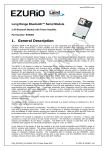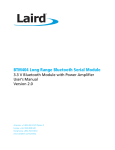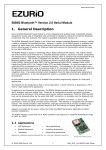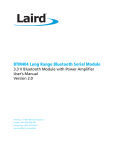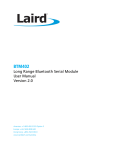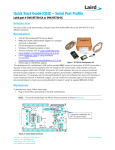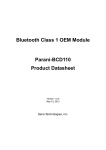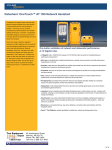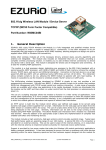Download TDK blu2i Network Card User Manual
Transcript
2i blu Module User Guide The information contained in this document is subject to change without notice. TDK Systems Europe makes no warranty of any kind with regard to this material including, but not limited to, the implied warranties of merchant ability and fitness for a particular purpose. TDK Systems Europe shall not be liable for errors contained herein or for incidental or consequential damages in connection with the furnishing, performance, or use of this material. © Copyright 2004 TDK Systems Europe Limited. All rights reserved. This document contains information that is protected by copyright. All rights reserved. No part of this document may be photocopied, reproduced, or translated to another language without the prior written consent of TDK Systems Europe. Other product or company names used in this publication are for identification purposes only and may be trademarks of their respective owners. 1 of 36 Contents BEFORE YOU BEGIN.................................................................................................................................................................... 3 SAFETY GUIDELINES ................................................................................................................................................................... 3 RF APPROVALS .......................................................................................................................................................................... 3 1 FUNCTIONS ...................................................................................................................................................................... 4 2 APPLICATION INTERFACE ............................................................................................................................................. 5 2.1 2.2 2.3 2.4 2.5 2.6 3 SERIAL INTERFACE ......................................................................................................................................................... 5 POWER SUPPLY ............................................................................................................................................................. 6 POWER-ON-RESET (POWER CYCLING AND BROWN OUT CONSIDERATIONS) ..................................................................... 6 SPI BUS ........................................................................................................................................................................ 8 PARALLEL PIO PORT ..................................................................................................................................................... 8 PCM CODEC INTERFACE ................................................................................................................................................ 8 ELECTRICAL SPECIFICATION OF THE INTERFACE .................................................................................................... 9 3.1 4 ELECTRIC CHARACTERISTICS ....................................................................................................................................... 11 PHYSICAL CHARACTERISTICS.................................................................................................................................... 13 4.1 4.2 4.3 5 MECHANICAL DIMENSIONS............................................................................................................................................ 13 2I MOUNTING THE BLU MODULE ONTO THE APPLICATION PLATFORM ................................................................................. 14 BOARD TO BOARD CONNECTOR.................................................................................................................................... 14 ELECTRICAL AND RADIO CHARACTERISTICS.......................................................................................................... 16 ABSOLUTE MAXIMUM RATINGS ...................................................................................................................................... 16 OPERATING TEMPERATURES......................................................................................................................................... 16 POWER CONSUMPTION ................................................................................................................................................ 16 LOW POWER MODES USING SNIFF ................................................................................................................................ 19 RF PERFORMANCE ....................................................................................................................................................... 21 5.5.1 Transmit Power ............................................................................................................................................. 21 5.5.2 Receive Sensitivity ........................................................................................................................................ 21 5.5.3 Range ............................................................................................................................................................ 21 5.5.4 Performance against Temperature................................................................................................................ 22 5.6 RELIABILITY ................................................................................................................................................................. 23 5.1 5.2 5.3 5.4 5.5 6 RS232 MODEM SIGNALS............................................................................................................................................... 24 6.1 6.2 6.3 7 PURE CABLE REPLACEMENT MODE.......................................................................................................................... 27 7.1 7.2 7.3 8 MODEM SIGNALLING OVER BLUETOOTH ......................................................................................................................... 25 BREAK SIGNAL ON RX LINE ......................................................................................................................................... 25 RESET ......................................................................................................................................................................... 26 DATA CABLE ................................................................................................................................................................ 27 AUDIO CABLE............................................................................................................................................................... 28 MODEM CONTROL AND STATUS SIGNALS ...................................................................................................................... 29 GETTING STARTED ....................................................................................................................................................... 30 2i 8.1.1 Two blu Modules.......................................................................................................................................... 30 2i 8.1.2 One blu Module and Bluetooth PC using TDK’s USB Adaptor or PC Card................................................. 31 8.2 FACTORY DEFAULT MODE ............................................................................................................................................ 32 8.3 SOFTWARE .................................................................................................................................................................. 32 APPENDIX A ................................................................................................................................................................................ 34 EUROPE – EU DECLARATION OF CONFORMITY .......................................................................................................................... 34 FCC AND INDUSTRY CANADA STATEMENTS ............................................................................................................................... 34 APPENDIX B ................................................................................................................................................................................ 35 ESD (ELECTROSTATIC DISCHARGE).......................................................................................................................................... 35 ADDITIONAL STATEMENT ........................................................................................................................................................... 35 WARRANTY ................................................................................................................................................................................. 36 2 of 36 Before You Begin Congratulations on your purchase of the TDK Systems blu2i Module. The Module is designed to be built into a device and to provide a simple, low cost Bluetooth interface. The module is designed to integrate with a wide range of applications and platforms with a simple electrical and software interface using AT commands. This guide aims to provide all the electrical and mechanical information needed to design applications using the blu2i Module. A separate document, blu2i Module - AT Command Set, outlines the protocol for the software interface. Safety Guidelines The following safety precautions must be observed during all phases of the operation, usage, service or repair of any application incorporating this Bluetooth Module. Manufacturers of the RF equipment are advised to convey the following safety information to users and operating personnel and to incorporate these guidelines into all manuals supplied with the product. Failure to comply with these precautions violates safety standards of design, manufacture and intended use of the product. TDK Systems assumes no liability for customer failure to comply with these precautions. RF Approvals The blu2i Module is listed as a Bluetooth Product in terms of the Bluetooth SIG Program Reference Document (PRD). This means that it can be integrated into end products without further testing or approval listing. The manufacturer must state the TDK part number and product reference in his literature in order to meet the requirements of the Bluetooth and regulatory approvals. A list of the countries where the module is approved will be provided by TDK Systems as required. As a minimum the product is listed in Europe, Scandinavia and USA. TDK Systems assumes no liability for customer failure to comply with national RF approvals. 3 of 36 1 Functions The blu2i Module contains a complete Bluetooth interface and requires no further hardware to implement full Bluetooth communication. The module has an integrated, high performance antenna together with all RF and Baseband circuitry, it interfaces to the host over a straight forward serial port using AT commands. The module runs specific firmware within the Virtual Processor that includes a serial Port Profile and AT command interpreter. The module can be configured so that it can be attached to a ‘dumb’ terminal or attached to a PC or PDA for cable replacement applications. The module provides access to 5 General I/O lines and 2 analogue I/O lines to provide Bluetooth connection to simple devices such as switches or LEDs without requiring any processing at the module end. blu2i Module features at a glance: Feature Bluetooth Transmission Frequency Minimum Transmit Power Maximum Transmit Power Receive Sensitivity Antenna Gain Range (see Section 6.1.3) Data Transfer Rate Physical size Weight Fully Bluetooth pre-qualified Current consumption Temperature Range Audio Implementation Class 1 2.400 – 2.485Ghz +0dBm +6dBm Better than -85dB +2dBi Up to 100 metres, free space Up to 200Kbps 24 x 69 x 5 mm 8g Bluetooth 1.1 PRODUCT listing Less than 36mA during data transfer -20°C to +75°C Audio can be transferred over SCO channels through the PCM interface at 64Kbps 4 of 36 2 Application Interface The blu2i Module is equipped with a 40-pin 0.5mm pitch board to board connector that connects to the application platform. Electrical and mechanical characteristics of the board-to-board connector are specified in Chapter 3. • Serial interface (see Section 3.0) • Electrical specification of the interface (see Section 3.1) 2.1 Serial Interface UART_TX, UART_RX, UART_RTS and UART_CTS form a conventional asynchronous serial data port. The interface is designed to operate correctly when connected to other UART devices such as the 16550A. The signalling levels are nominal 0V and 3.3V and are inverted with respect to the signalling on an RS232 cable. The interface is programmable over a variety of bit rates; no, even or odd parity; stop bit and hardware flow control. The default condition on power-up is preassigned in the external Flash. Two-way hardware flow control is implemented by UART_RTS and UART_CTS. UART_RTS is an output and is active low. UART_CTS is an input and is active low. These signals operate according to normal industry convention. By writing different values to the S register the UART_RI can be continuously polled to detect incoming communication. The UART_RI signal serves to indicate incoming calls. UART_DSR is an active low input. It should be connected to DTR output of the host. When the module is running in high speed mode (See definition for S Register 512), this pin should be asserted by the host to ensure connection is maintained. A deassertion is taken to mean that the connection should be dropped, or an online command mode is being requested. The module communicates with the customer application using the following signals: RS-232 • Port /TXD @ application sends data to the module’s UART_RX signal line • Port /RXD @ application receives data from the module’s UART_TX signal line 5 of 36 blu2i Module Application /RXD /TXD /RTS /CTS /DTR /DSR /DCD /RING RS232 Interface UART Interface UART_TX UART_RX UART_CTS UART_RTS UART_DTS UART_DTR UART_DCD UART RI Figure: UART interfaces 2.2 Power Supply The power supply for the blu2i Module has to be a single voltage source of Vcc= 3.6V to 6V. It must be able to provide sufficient current in a transmit burst which can rise to 65mA. The module includes regulators to provide local 3.3V and 1.8V. These rails are accessible on connector J2 for monitoring. Power (Vcc) should be provided via the board-to-board connector Pin 29 on J2. Section 5.3 details the power consumption in different modes. 2.3 Power-On-Reset (Power Cycling and Brown Out considerations) The Module is provided with an active high reset pin (Hirose 40 way DF12C connector pin 13). This pin whose electrical specification may be found in section 3.3 is internally pulled to ground through a 10KΩ resistor. Upon the application of power, the Power On Reset circuit built into the module will ensure that the unit starts correctly. However the module utilises a split rail design with some components working at 3V3 and some at 1V8. Under certain extreme conditions, for 6 of 36 example when the supply voltage to the module experiences a BrownOut (momentary dip in the supply voltage level), or a rapid power cycle i.e. the power is switched off and then on within 1second, there is a possibility that the module can enter an unknown state of operation. It is strongly recommended that the application hardware onto which the module is mounted provides a Power-On-Reset circuit with a Brown-Out detection capability. This will guarantee that under all circumstances the module will operate in a known state. A device such as the Maxim MAX6382XR26D3-T would be a suitable part to perform the reset – it has an active high push-pull output, a 2.63V detection threshold, and an active reset period of 140ms. This inexpensive device is available in a SC70-3 package (2.2mm x 2.4mm) and requires no additional components to operate. The device is used to monitor the output of the voltage regulator on the module (through pin 27), and drives the Reset line (pin13) high when the supply voltage falls out of tolerance. The schematic below illustrates its use. Please note that this 3V3 is the output of the 3V3 regulator on the blu2i Module and should not be connected to any other supplies on the application hardware. blu2i Module BC02 3V3 Pin27 BC02 MRESET Pin13 3 Vcc MAX6382 Gnd Reset 1 2 10K GND GND 7 of 36 2.4 SPI Bus The module is a slave device that uses terminals SPI_MOSI, SPI_MISO, SPI_CLK and SPI_CSB. This interface is used for program firmware update. Note: The designer should be aware that no security protection is built into the hardware or firmware associated with this port, so the terminals should not be permanently connected in a PC application. 2.5 Parallel PIO Port Five lines of programmable bi-directional input/outputs (I/O) are provided. GPIO[1:5] are powered from VCC. The mode of these lines can be configured and the lines are accessed via S Registers 621 to 625. Auxiliary functions available via these pins include an 8-bit ADC and an 8-bit DAC. This function is not implemented at this time. 2.6 PCM Codec Interface PCM_OUT, PCM_IN, PCM_CLK and PCM_SYNC carry up to three bidirectional channels of voice data, each at 8K samples/s. The format of the PCM samples can be 8-bit A-law, 8-bit µ-law, 13-bit linear or 16-bit linear. The PCM_CLK and PCM_SYNC terminals can be configured as inputs or outputs, depending on whether the module is the Master or Slave of the PCM interface. The blu2i module is compatible with the Motorola SSI TM interface and interfaces directly to PCM audio devices including the following: • Qualcomm MSM 3000 series and MSM 5000 series CDMA baseband devices • OKI MSM7705 four channel A-law and µ-law CODEC • Motorola MC145481 8-bit A-law and µ-law CODEC • Motorola MC145483 13-bit linear CODEC 8 of 36 3 Electrical specification of the interface The Hirose DF12C board to board connector on the module is a 40 way double-row receptacle. The pin allocation is as follows: Pin 1 3 5 Signal Analogue 0 Analogue 1 SPI_MISO 7 SPI_CSB 9 SPI_CLK 11 GND 13 RESET 15 GND 17 SPI_MOSI 19 UART_CTS 21 UART_TX 23 UART_RTS 25 UART_RX 27 VCC_3V3 29 VCC_5V 31 33 35 37 39 N/C N/C N/C N/C VCC_1V8 Description 1.8v Max 1.8v Max SPI bus serial O/P SPI bus chip select I/P SPI bus clock I/P Reset I/P SPI bus serial I/P Clear to Send I/P Transmit Data O/P Request to Send O/P Receive Data I/P 3.3V Output (Note 3) 3.6V < VIN < 6.0V 1.8V Output (Note 3) Pin 2 4 6 Signal GPIO1 GPIO2 UART_RI 8 UART_DCD Description I/O for Host I/O for Host ‘Ring’ Input or Output Input or Output 10 UART_DSR Input 12 I/O for Host 14 GPIO3/UART _DTR GPIO4 16 GPIO5 18 GND 20 PCM_CLK PCM Clock I/P 22 PCM_IN PCM Data I/P 24 PCM_SYNC PCM Sync I/P 26 PCM_OUT PCM Data O/P 28 N/C 30 GND 32 34 36 38 40 RESERVED RESERVED GND GND N/C 9 of 36 I/O for Host (Right LED)(2) I/O for Host (Left LED) (2) Do not connect Do not connect Notes: • UART_RX, UART_TX, UART_CTS, UART_RTS, UART_RI, UART_DCD and UART_DSR are all 3.3v level logic. For example, when RX and TX are idle they will be sitting at 3.3V. Conversely for handshaking pins CTS, RTS, RI, DCD, DSR a 0v is treated as an assertion. • Pin 6 (UART_RI) is active low. It is normally 3.3v. When a remote device initiates a connection, this pin goes low. This means that when this pin is converted to RS232 voltage levels it will have the correct voltage level for assertion. • Pin 8 (UART_DCD) is active low. It is normally 3.3v. When a connection is live this pin is low. This means that when this pin is converted to RS232 voltage levels it will have the correct voltage level for assertion. • Pin 10 (UART_DSR) is an input, with active low logic. It should be connected to the DTR output of the host. When the blu2i Module is in high speed mode (See definition for S Register 512), this pin should be asserted by the host to ensure that the connection is maintained. A deassertion is taken to mean that the connection should be dropped, or an online command mode is being requested. • The GPIOn pins can be accessed using S Registers 621 to 625 • GPIO4 and GPIO5 are also connected to LEDs on the module. If these I/O pins are set for input, then the LED will be driven by the host and appropriate drive current requirements must be satisfied. By default GPIO4 is used to drive the right LED which indicates connection status. A Logic 1 switches on the LED. • Analogue 0 and 1 should not exceed 1.8v and S Registers 7xx are used to access them. • GPIO3 is used for DTR output (active low). 10 of 36 3.1 Electric Characteristics Function Power Supply RS232 Interface External Power Supply SPI Bus Signal Name Vcc Pin No 29 I/O I GND 11, 15, 18, 30, 36, 38 UART_TX 21 O UART_RX 25 I UART_CTS 19 I UART_RTS 23 O UART_DSR 10 I UART_DTR 12 O UART_RI 6 I or O UART_DCD 8 I or O VCC_1V8 39 O VCC_3V3 SPI_MOSI 27 17 O I SPI_MISO 5 O SPI_CSB 7 I SPI_CLK 9 I Signal level 3.6V to 6V Comments Ityp = 50mA 6 Ground terminals to be attached in parallel 11 of 36 VOLmax=0.2V VOHmin=2.8V VILmax=0.8V VIHmin=2.10V VIHmax=3.7V VILmax=0.8V VIHmin=2.10V VIHmax=3.7V VOLmax=0.2V VOHmin=2.8V VILmax=0.8V VIHmin=2.10V VIHmax=3.7V VOLmax=0.2V VOHmin=2.8V O/P : VOLmax=0.2V VOHmin=2.8V I/P : VILmax=0.8V VIHmin=2.10V VIHmax=3.7V O/P : VOLmax=0.2V VOHmin=2.8V I/P : VILmax=0.8V VIHmin=2.10V VIHmax=3.7V 1.8V typical 3.3V typical VILmax=0.8V VIHmin=2.10V VIHmax=3.7V VOLmax=0.2V VOHmin=2.8V VILmax=0.8V VIHmin=2.10V VIHmax=3.7V VILmax=0.8V Shared with GPIO3 Direction may be programme d. Direction may be programme d. For monitoring only. No current source Used to reprogram Flash PCM Interface PCM_CLK 20 I or O PCM_IN 22 I PCM_SYNC 24 I or O PCM_OUT 26 O BC02 USB D- 32 I 34 I GPIO BC02 USB D+ GPIO 1 - 5 2,4,12, 14,16 I or O Analog I/O AIO_0, AIO_1 1, 3 I/O Reset RESET 13 I Reserved 12 of 36 VIHmin=2.10V VIHmax=3.7V O/P : VOLmax=0.2V VOHmin=2.8V I/P : VILmax=0.8V VIHmin=2.10V VIHmax=3.7V VILmax=0.8V VIHmin=2.10V VIHmax=3.7V O/P : VOLmax=0.2V VOHmin=2.8V I/P : VILmax=0.8V VIHmin=2.10V VIHmax=3.7V VOLmax=0.2V VOHmin=2.8V VILmax =0.3vdd_pads VIHmin =0.7cdd_pads VILmax =0.3vdd_pads VIHmin =0.7cdd_pads O/P : VOLmax=0.2V VOHmin=2.8V I/P : VILmax=0.8V VIHmin=2.10V VIHmax=3.7V Vout max=VDD_PIO.3 Vout min=VDD_PIO VDD falling threshold=1.5V typ VDD rising threshold=1.6V typ If unused keep pins open Normally inactive. Pull to GND through 10K 4 Physical Characteristics 4.1 Mechanical Dimensions 13 of 36 4.2 Mounting the blu2i Module onto the application platform There are many ways to properly install the Module in a host device. An efficient approach is to mount the PCB to a frame, plate, rack or chassis. Fasteners can be M1.8 or M2 screws plus suitable washers, circuit board spacers, or customized screws, clamps, or brackets in 2.2mm diameter holes. Note that care should be taken to ensure the head of the fixing does not interfere with the circuit. Nylon fixings are recommended. In addition, the board to board connection can also be utilized to achieve better support. The antenna (Brown square component on top side of PCB) must not be influenced by any other PCBs, components or by the housing of the host device. The proximity of the antenna to large metallic objects can affect the range and performance of the system. Designers should carefully consider the location of the module and the type of enclosure material that is used. To prevent mechanical damage, be careful not to force, bend or twist the module. Be sure it is positioned flat against the host device. 4.3 Board to Board Connector This section provides specifications for the 40 way board-to-board connector which serves as physical interface to the host application. The receptacle assembled on the blu2i Module is type Hirose DF12C. Item Receptacle on Module Part number DF12C-40DS0.5V(81) Stacking height 3.5mm - 5mm 14 of 36 HRS number CL537-0007-7- Mating headers from Hirose are available in different stacking heights. Details are available at: http://www.hirose.co.jp/cat2002e/500/e53700036.pdf Item Headers DF12 series Part number DF12(3.5)-40DP0.5V(81) DF12(4.0)-40DP0.5V(81) DF12(5.0)-40DP0.5V(81) Stacking height 3.5mm 4.0mm 5.0mm HRS number CL537-0032-4** CL537-0057-5** CL537-0157-0** Note: The headers listed above are without boss and metal fitting. Electrical and mechanical characteristics of the Hirose DF12C connector: Parameter Number of Contacts Quantity delivered Voltage Current Rating Resistance Dielectric Withstanding Voltage Operating Temperature Contact Material Insulator Stacking height Insertion force Withdrawal force 1st Withdrawal force 50th Maximum connection cycles Specification (40 pin Board to Board connector) 40 2000 Connectors per Tape & Reel 50V 0.5A max per contact 0.05 Ohm per contact 500V RMS min -45°C to +125°C phosphor bronze (surface: gold plated) Material PA , beige natural 3.0 mm; 3.5 mm; 4.0 mm; 5.0 mm 21.8N 10N 10N 50 15 of 36 5 Electrical and radio characteristics 5.1 Absolute Maximum ratings Absolute maximum ratings for supply voltage and voltages on digital and analog pins of the module are listed below. Exceeding these values will cause permanent damage. Minimum 0mA -0.3V 3.3V Peak current of power supply Voltage at digital pins Voltage at POWER pin Maximum 100mA 3.7V 7V 5.2 Operating temperatures Minimum -20°C Operating temperature Typical 25°C Maximum +75°C 5.3 Power Consumption The current drain from the Vcc power input line is dependent on various factors. The three most significant factors are the voltage level at Vcc, UART baud rate and the operating mode. The hardware specification for the blu2i module allows for a voltage range of 3.6 to 6.0v at Vcc. Tests have shown that there is no significant difference in current draw when Vcc is 5 or 6V. Therefore the data presented below, pertains to Vcc levels of 3.6 and 5v only. Tests have shown that where power drain is an issue, it is best to keep Vcc at the lower end of the range. The UART baud rate has a bearing on power drain because as is normal for digital electronics, the power requirements increase linearly with increasing clocking frequencies. Hence higher baud rates result in a higher current drain. Finally with regards to operating mode the significant modes are; idle, waiting for a connection, inquiring, initiating a connection and connected. With connected mode, it is also relevant to differentiate between no data 16 of 36 being transferred and when data is being transferred at the maximum rate possible. The operating mode can best be described by stating the AT commands required to enter that mode. In addition, there are certain S Registers which have a direct impact on power consumption, which are described next. The blu2i Module has 2 LEDs which can be configured to display connection status. One led is used to display connection status, while the other is used to either display ‘Ring Indicate’ status or follow the state of the incoming DSR line on the UART interface. Tests have shown that these LEDs can consume up to 5.3mA which is more than double the current draw when in Idle mode. Therefore S Registers 533 and 534 can be used to completely disable these indications. Finally S Registers 508 to 511, which specify the page and inquiry scan intervals and windows, can be used to adjust the average current drain when in discoverable and or connectable modes. Registers 508 and 509 specify the interval and window for page scans and registers 510 and 511 specify the interval and window for inquiry scans. Register pairs 508/509 and 510/511 describe duty cycles when the blu2i module goes into scan modes. It is while scanning that the highest current draw occurs. The average current draw is determined by simple arithmetic using the values stored in the 508/509 and 510/511 register pairs. The operating modes described above are entered using AT commands as follows Idle Wait for Connection Discoverable Only Connecting Connected Connected On power up, with S Register 512 = 1 AT+BTG (100% page scan duty cycle) AT+BTQ (100% inquiry scan duty cycle) ATD No Data Max data transfer All current consumption values in the table below assume that the connection status indication functionality of the LEDs has been disabled by setting S Registers 533 and 534 to 0. All current values are in milliamps (mA). 17 of 36 Current per LED Idle Mode, S512=1 Wait for Connection Or Discoverable Mode, AT+BTP S508=S510=640, S509=S511=320 Wait for Connection Or Discoverable Mode, AT+BTP S508=S510=1000, S509=S511=11 Inquiring Mode, AT+BTI Connecting Mode (ATDxxx) Connected as Master Mode (No Data Transfer) Sniff NOT activated Connected as Master Mode (Max Data Transfer) Sniff NOT activated Connected as Slave Mode (No Data Transfer) Connected as Slave Mode (No Data Transfer) Sniff Enabled (AT&F1 setting) 9600 3.20 5.30 Baud rate 38400 115200 460800 3.20 3.20 3.20 5.30 5.30 5.30 3.6V 5.0V 3.6V 5.0V 9600 1.60 2.00 59.00 65.00 Baud rate 38400 115200 1.80 1.96 2.10 2.30 59.00 59.00 65.00 65.00 460800 3.00 3.40 59.00 65.00 3.6V 5.0V 2.75 3.26 2.94 3.36 3.10 3.55 4.12 4.63 3.6V 5.0V 3.6V 5.0V 3.6V 5.0V 50.00 54.00 50.00 54.00 6.00 7.20 50.00 54.00 50.00 54.00 6.10 7.20 50.00 54.00 50.00 54.00 6.40 7.40 50.00 54.00 50.00 54.00 7.20 8.20 3.6V 5.0V 21.50 24.50 22.50 26.00 24.50 28.00 32.50 36.00 5.0V 32.00 33.00 33.50 34.00 5.0V 4.90 3.6V 5.0V As can be seen, the current drain while waiting for a connection or discoverable mode is about 30 times higher than in idle mode. This is when the page/inquiry scan duty cycle is 100%. These modes give the quickest response to a page or inquiry request from a remote peer. 18 of 36 It is possible to reduce the duty cycle down to as low as 0.5% at the expense of response time. The response time can be specified via S Registers 508 and 510 for page and inquiry respectively, where the worst case response time can be as high as 2.5 seconds. Then the duty cycle can be varied by changing the value of S Registers 509 and 511 appropriately. For example, if S Register 508 and 510 are both set to 1000ms and S Register 509 and 511 are both set to 11ms then the duty cycle is reduced to 1%, this means that average current drain at 5.0v will be 2% of 65mA plus the normal idle mode current, that is, it is as low as 2.75mA. However, in this case, it can take up to 1 second to establish a connection. The connected state current consumption while a master or slave can be considerably reduced by enabling Sniff mode, described in detail in the next section. 5.4 Low Power Modes using Sniff Bluetooth connections are master/slave in nature. A master sends packets and a slave has to acknowledge that packet in the next timeslot. Timeslots in Bluetooth are 625 microseconds wide. This implies that a master will always know when packets will be sent and received, which further means it is able to optimise power usage by switching on power hungry circuitry only when needed. A slave on the other hand does NOT have prior knowledge of when a packet will be received and has to assume that a packet will be received from a master on every receive slot. This means that it has to leave it’s receiving circuitry on for most of the receive slot duration. The result of this is high power consumption as illustrated in the power table above, where a slave with no data transmission still consumes around 31mA whereas a master consumes only 6mA. This problem was identified very early in the evolution of Bluetooth (especially since headsets spend all their time as a slave in a Bluetooth connection) and it was solved by having a mode called Sniff, with appropriate lower layer negotiating protocol. Sniff mode during connection is basically an agreement between the slave and its master that data packets will only be exchanged for N timeslots every M slots. The slave can then assume that it will never be 19 of 36 contacted during N-M slots, and so can switch its power hungry circuitry off. The specification goes further by also specifying a third parameter called ‘timeout’ (T) which specifies ‘extra’ timeslots that the slave will agree to listen for after receiving a valid data packet. Put another way, if a data packet is received by the slave, then it knows that it MUST carry on listening for at least T more slots. If within that T slot time period another data packet is received, then the timer is restarted. This mechanism ensures low power consumption when there is no data transfer – at the expense of latency. When there is a lot of data to be transferred, it acts as if sniff mode were not enabled. It is stated above that during sniff mode, a slave listens for N slots every M slots. The Bluetooth specification states that a master can have up to 7 slaves attached to it with all slaves having requested varying sniff parameters. It may therefore be impossible to guarantee that each slave gets the M parameter it requested. In light of this, the protocol for enabling sniff mode specifies that a requesting peer specify the M parameter as a minimum and maximum value. This will allow the master to interleave the sniff modes for all slaves attached. For this reason, the sniff parameters are specified in TDK module via four S registers. S Register 561 is used to specify ‘N’, S Register 562 is used to specify ‘T’ and S Registers 563/564 are used to specify minimum ‘M’ and maximum ‘M’ respectively. Although the specification defines these parameters in terms of timeslots, the S register values have to be specified in units of milliseconds and the firmware does the necessary translation to timeslots. Low Power Consumption T Slots T Slots Data Exchange Data Exchange Data Data Exchange Exhange Data Exchange Data Exchange High Power Consumption T Slots T Slots N Slots T Slots N Slots M Slots (Negotiated) N Slots M Slots (Negotiated) 20 of 36 5.5 RF performance 5.5.1Transmit Power Conducted Transmit Power: Antenna Gain: Effective Transmit Power: minimum: 1mW (0dBm) maximum: 4mW (6dBm) Power class 1 +2dBi typical. min: 2dBm max:8dBm 5.5.2Receive Sensitivity Receive Sensitivity: Antenna Gain: Effective Receive Sensitivity: -86dBm (at 25ºC) +2dBi typical -88dBm (at 25ºC) Receive Sensitivity 0 -40 deg -20 deg 0 deg 20 deg 40 deg 60 deg 80 deg 100 deg -10 -20 Attenuation Setting dBm -30 -40 -50 -60 -70 -80 -90 NOTE: Measured as attenuation required to achieve better than 0.1% BER -100 Temperature Deg. C. 5.5.3Range See Data Transfer Rate vs distance. The data throughput of the blu2i Module is limited to 200Kbps by the parsing of the data being transferred through the AT command processor. The graph below shows the best 21 of 36 case data though-put with and without the AT command processing. Distances are measured in free space between 2 blu2i Modules. Data Transfer Rate / Distance 800 700 Data Transfer Rate (kbps) 600 500 RF data rate Serial port data rate 400 300 200 100 0 10m 50m 100m 150m 200m 250m 300m Distance (meters) 5.5.4Performance against Temperature Data Transmit Rate with Temperature and Attenuation 800 700 600 Data Transmission Rate kbs -40 deg -20 deg 500 0 deg 20 deg 400 40 deg 60 deg 300 80 deg 200 100 deg 100 0 -60dBm -65dBm -70dBm -75dBm dBm attenuation 22 of 36 -80dBm -85dBm -90dBm 5.6 Reliability Parameter Thermal Shock Vibration Shock Moisture Resistance High Temp Storage Low Temp Storage High Temp/Humidity Operation High Temp/Humidity Storage Thermal shock Electro Static Discharge Drop Test Minimum 200cycles -40ºC /+85ºC 30 min Continuous operation at 60 Hz, 2mm stroke 50G 11ms Half Sine Wave Maximum 1 cycle/hour 15g max sine wave, 12 hours 6 axis x 3 cycles each axis 85ºC, 360 hours -40ºC, 240 hours 60ºC, 90%RH, 360 hours -40 to 60ºC in 30min EN55024:1998 & IEC61000-4-3 75cm to concrete, 3 axis x 2 cycles per corner 23 of 36 200 cycles with continuous operation 6 RS232 Modem Signals Just as a telephony modem has control and status lines, the blu2i Module also provides for 6 control and status lines as per the table below. The direction column is as seen from the modules viewpoint. Direction IN or OUT IN or OUT IN OUT IN OUT Function CI also known as RI (Ring Indicate) DCD (Data Carrier Detect) DSR (Data Set ready) DTR (Data Terminal Ready) CTS (Clear to Send) RTS (Request to Send) The first four lines are under program control and as such require GPIO pins and they are mapped to I/O as per the table below. The last two are under control of the UART driver and their functionality is always enabled. PIO Pin 0 1 2 3 4 5 Direction Connector Pin Label Function IN/OUT IN/OUT IN/OUT IN/OUT IN IN/OUT GPIO1 GPIO2 UART_RI UART_DCD UART_DSR GPIO3/UART_DTR 6 IN/OUT GPIO4 7 IN/OUT GPIO5 General Purpose I/O General Purpose I/O Input/Output from module Input/Output from module Input to Module General Purpose I/O (or DTR functionality) General Purpose I/O (Right LED) General Purpose I/O (Left LED) Notes: 1 PIO4 (DSR) is used by the blu2i module to sense that the host is connected, and is intricately linked with connections. For outgoing calls, if this line is not asserted then an error is immediately. Similarly for AT+BTP and AT+BTG. While in a call, for appropriate modes, a deassertion means fall into command state. If the deassertion exists for longer than the period 24 of 36 specified in S Register 519 then the connection is dropped as if an ATH command was received. 2 PIO2 (RI), is normally deasserted. When an incoming connection is detected it will be asserted, until the connection is either answered or rejected using ATA and ATH respectively. See S Registers 552 & 553 for more details 3 PIO3 (DCD) will be deasserted when the device is in the unconnected state. Asserted when a connection is active. See S Registers 552 and 553 for more details. 4 PIO5 is either used as GPIO or driven as UART_DTR. When the unit is configured in pure host mode, this pin is forced into UART_DTR and is asserted when there is a Bluetooth connection. GPIO Pins 1,2,3,4 and 5 are available for general purpose use. 6.1 Modem signalling over Bluetooth The RFCOMM protocol used in Bluetooth for implementing the serial port profile allows for the exchange of four modem signals. This information is contained in a special transparent message which contains bits identified as RTR, RTC, DV and IC which depending on the type of serial device being emulated maps to DTR or DSR, RTS, DCD and RI respectively. In addition, this message also includes the ability to convey a BREAK input from one end to the other. So to allow for the greatest flexibility and variability in how the modem control signals are used out in the real world, S Registers 551, 552 and 553 have been provided which allow for any of RTR,RTC,DV and IC to be mapped to any modem control/status line. 6.2 BREAK signal on RX line If the host sends a break signal of duration greater than 100ms, then the blu2i module is configured to treat that as a signal to perform a hardware reset. This being the case it is not possible to convey a BREAK over Bluetooth to the peer device. 25 of 36 Future enhancement may allow the BREAK signal to be used to map to GPIO which with appropriate external hardware may allow for a BREAK to be reproduced on the TX line. 6.3 Reset The module can be reset by the host without the need of any I/O using a BREAK signal. The module has been configured to reset when the RX line detects a break condition for durations greater than 100 milliseconds. 26 of 36 7 Pure Cable Replacement Mode 7.1 Data Cable The module has the capability of being preset into a pure 5-wire data cable replacement mode. The 5 wires being RX, TX, CTS, RTS and GND. This mode requires no changes to a host application since the Bluetooth connection is automatically set up on power up and will retry when the connection drops. By implication, two devices are needed to replace a cable. One device is pre-configured to always be a master and the other, a slave. Assuming the Bluetooth address of the master to be <bdaddr_m> and that of the slave to be <bdaddr_s>, the master module is configured by sending it the following AT commands. AT&F ATS512=1 ATS504=1 ATS507=2 ATS530=2000 AT&W AT+BTR<bdaddr_s> Where the ATS507=2 setting puts the device in DSR drop mode only. This means that when the device needs to be reconfigured, deasserting the DSR line will ensure that the module responds quickly to AT commands. This further means that in stand alone mode, the DSR input line MUST be asserted e.g. 0v in TTL signal mode. The slave is configured by, AT&F ATS512=4 ATS0=-1 AT&W AT+BTR<bdaddr_m> 27 of 36 Where <bdaddr_m> is optional. If it is not specified, then the slave unit will accept connections from any device. If specified then only connections from the device specified will be accepted. If it is desired that the slave unit not be discoverable (the master is by default not discoverable), then the configuration commands are, AT&F ATS512=3 ATS0=-1 AT&W AT+BTR<bdaddr_m> Where <bdaddr_m> is optional. If it is not specified, then the slave unit will accept connections from any device. If specified then only connections from the device specified will be accepted. When the units are next power cycled, the slave unit will wait for the master to connect to it and the master will continually look for the slave. If a connection attempt fails, the master will wait for 2 seconds before reattempting a connection. This 2 second delay can be varied by issuing it an ATS530 command with an appropriate value in the range 100ms to 15000ms. IMPORTANT NOTE: When S Register 507 = 0, the DSR input to the module MUST be asserted for the auto connection to succeed. When operating at TTL levels a 0V is seen as an assert state. When operating at RS232 levels and voltage greater than 3V is seen as assert. It is usual to connect the DTR line of the host to the DSR line of this device. 7.2 Audio Cable With a pair of these modules it is possible to replace a mono audio cable with two way traffic. That is, a setup where a microphone is connected to a speaker at the remote end and vice versa. So this mode effectively replaces two audio cables. Assuming the Bluetooth address of the master to be <bdaddr_m> and that of the slave to be <bdaddr_s>, the master module is configured by sending it the following AT commands. AT&F ATS512=1 28 of 36 ATS504=1 ATS530=2000 ATS532=1 AT&W AT+BTR<bdaddr_s> And the slave is configured by, AT&F ATS512=4 ATS0=-1 AT&W AT+BTR<bdaddr_m> 7.3 Modem Control and Status Signals A serial port has DTR, DSR, RTS, CTS, DCD and RI control lines. RTS and CTS are locally controlled to prevent local buffer overflow. However the status of DTR, DRS, DCD and RI can be exchanged with the remote peer device. If for example, the DTR/DSR lines are to be exchanged between the two peers to simulate the performance of a physical cable, then it is possible to do so. Refer to the description for S Registers 551, 552 and 553 for more details. 29 of 36 8 Getting Started This section describes how to quickly make your first Bluetooth connection based on the following combinations of Bluetooth hardware:1. Two blu2i Modules. 2. One blu2i Module and a Bluetooth Enabled PC using TDK’s Go Blue USB Adaptor or PC Card. Note: The following examples assume that a PC is used to control the blu2i Module using a Terminal Emulation application. 8.1.1Two blu2i Modules Assuming your PC has 2 serial ports (COM1 and COM2) or that you have 2 PCs that each have one free serial port, attach a blu2i Module to each COM port. Launch a terminal emulation for each COM port and start off with comms parameters 9600,N,8,1. Type AT<enter> and confirm that you see it echoed and then an OK response. If you do not see this behavior, close the application and restart with comms parameters 115200,N,8,1 and try again. On the first terminal emulator application, enter the following commands:ATI4 ATS0=1 AT+BTP The response to ATI4 will be the modules Bluetooth address in the form of a 12 digit hex number. On the second terminal emulator app, enter the following command:ATD<bd_addr> Where <bd_addr> is the 12 digit Bluetooth address you saw in response to ATI4 above. After a moment, you will see the response “CONNECT <bd_addr>” on both terminal emulators. This confirms that you have a Bluetooth connection between the two. 30 of 36 Now typing characters on one terminal emulator will result in them being displayed on the other terminal emulator, proving wireless communications. 8.1.2One blu2i Module and Bluetooth PC using TDK’s USB Adaptor or PC Card Assuming your PC has 1 serial port (COM1) with a blu2i Module attached and the latest Windows Bluetooth stack from TDK installed. Also confirm that the TDK Go Blue USB Adaptor or PC Card is connected to your PC and that it is functional. You can confirm this by checking that the Bluetooth icon in the system tray area has a White B on a blue background. Red on blue implies no Bluetooth device is attached to the PC. Run a terminal emulation application and attach to COM1 at either 9600,N,8,1 or 115200,N,8,1 and confirm that you get an OK response when you type in the following command: AT Then enter the following commands to prepare it for an incoming Bluetooth connection: ATS0=1 AT+BTP Then launch “My Bluetooth Places” on your PC and perform an inquiry. You will see a device appear named “TDK blu2i XXXXXX”. Double click on that item and you will see the service profiles screen where the SPP profile will be displayed. Double click on that profile item and eventually you will get a dialog box to confirm that a connection has been established. It will also advise which virtual COM port it uses for communication with peer device. Run a terminal emulation application and attach to that virtual COM port at 115200,N,8,1. Typing characters will see them being echoed in the other terminal emulation application. 31 of 36 8.2 Factory Default Mode The module is capable of operating at a very wide range of baud rates and S Registers 520 and 521 allow the baud rate to be set very easily. The baud rate clock generator in the module is more versatile that that available in a standard 16550 UART commonly available in PCs. In fact, as long as the equation BAUDRATE * 0.004096 produces an integer value, then there will be 0% error in clocking for that baud rate. So it is possible to set a baud rate that a PC cannot cope with, and in that circumstance it is virtually impossible to communicate with it. To cater for this circumstance, the blu2i module will come out of reset using 9600,N,8,1 comms settings for exactly 750 milliseconds and then revert to the comms parameters as per the S Registers. If the host sends the string !<BISM>!<cr> where <cr> is the carriage return character within that 750ms period, then the module will remain at 9600,N,8,1 and will also configure itself using factory default S Register values. Please see the next section for a discussion on Terminal Emulators and how you can obtain a terminal emulator which has this ‘reset’ feature built in. 8.3 Software The Bluetooth Module described in this document uses the serial interface to accept commands and provide responses. While in command mode all interaction between it and a host is done purely in text mode. This means that virtually all terminal emulators available are adequate for testing and prototyping. HyperTerminal, Procomm or the TDK Terminal application supplied are all suitable terminal emulators. TDK Terminal is a terminal emulation application capable of running on Windows 98, Me, 2000 and XP operating systems. It was developed specifically to aid development and testing of the blu2i Module. It allows connection to serial devices using any combination of the following communications parameters: COM Port: 1 to 255 32 of 36 Baud rate: 300 to 921600 Parity: None, Odd, Even Data Bits: 7 or 8 Stop Bits: 1 or 2 Handshaking: None or CTS/RTS The unique benefits of using TDK Terminal are: • • • • Status of DSR, CTS, DCD and RI are continuously displayed DTR can be directly controlled via a check box RTS can be directly controlled BREAK signals can be sent Also, there is a “Data Transfer Test” mode allowing data to be sent as fast as the handshaking will permit. This feature is very useful for testing the bit transfer rate of a Bluetooth connection. TDK Terminal is included on the blu2i CD and is also available for download from http://www.blu2i.com. 33 of 36 Appendix A Europe – EU Declaration of Conformity DECLARATION OF CONFORMITY In accordance with Annex IV of the EU directive 1999/5/EC Notified Body consulted: ID-Number of Notified Body: Phoenix Test-Lab 0700 declare under our responsibility that the blu2i Module complies with the appropriate essential requirements of the Article 3 of the R&TTE and the other relevant provisions, when used for its intended purpose. Health and Safety requirements contained in Article 3 (1) a) EN 60 950: 1992 Safety of information technology equipment + Amendment A1:1993, Amendment A2:1993, Amendment A3:1995, Amendment A4:1997, Amendment A11:1997 EN 50371: Generic standard to demonstrate the compliance of low-power electronic and electrical apparatures with the basic restrictions related to human exposure to electromagnetic fields (10 MHz - 300 GHz) – General public Protection requirements with respect to electromagnetic compatibility Art.3 (1) b) EN 301489-17 V1.1.1 (09-2000), Electromagnetic Compatibility and radio spectrum Matters (ERM); ElectroMagnetic Compatibility (EMC) standard for radio equipment and services; Part 17: Specific conditions for wideband data Hiperlan equipment Means of the efficient use of the radio frequency spectrum EN 300328-2 V1.2.1 (11-2001), Radio Equipment and Systems (RES); Wideband transmission systems; Technical characteristics and test conditions for data transmission equipment operating in the 2,4 GHz ISM band and using spread spectrum modulation techniques. Part 2: Harmonized EN covering essential requirements under article 3(2) of the R&TTE directive. TDK Systems Europe Ltd tel: +44 (0)20 8938 1000 126 Colindale Avenue, Colindale fax: +44 (0)20 8905 8608 London NW9 5HD, United Kingdom www.tdksys.com Registered in England No. 2348741 FCC and Industry Canada Statements This device complies with part 15 of the FCC Rules. Operation is subject to the following two conditions: (1) This device may not cause harmful interference, and (2) this device must accept any interference received, including interference that may cause undesired operation. Changes or modifications not expressly approved by the party responsible for compliance could void the user's authority to operate the equipment. 34 of 36 Appendix B ESD (Electrostatic Discharge) If your TDK Bluetooth device is affected by ESD, it is recommended that you restart any Bluetooth processes that were active at the time. Additional Statement TDK SYSTEMS' BLUETOOTH PRODUCTS ARE NOT AUTHORISED FOR USE AS CRITICAL COMPONENTS IN LIFE SUPPORT DEVICES OR SYSTEMS WITHOUT THE EXPRESS WRITTEN APPROVAL OF THE MANAGING DIRECTOR OF TDK SYSTEMS EUROPE. The definitions used herein are: a) Life support devices or systems are devices which (1) are intended for surgical implant into the body, or (2) support or sustain life and whose failure to perform when properly used in accordance with the instructions for use provided in the labelling can reasonably be expected to result in a significant injury to the user. b) A critical component is any component of a life support device or system whose failure to perform can be reasonably expected to cause the failure of the life support device or system, or to affect its safety or effectiveness. 35 of 36 Warranty TDK warrants that its products shall conform to TDK’s published specifications and remain free from defects in materials and workmanship under normal, proper and intended use for a period of two (2) years from date of purchase, provided that proof of purchase be furnished with any returned equipment. If during the warranty period any component part of the equipment becomes defective by reason of material or workmanship, and TDK is immediately notified of such defect, TDK shall at its option supply a replacement part or request return of equipment, freight prepaid, to its designated facility for repair. In the event no trouble is found on products returned for repair, TDK reserves the right to charge the customer its standard published repair charge. This warranty shall not apply to any products that have been subject to misuse, bending, twisting, neglect, alteration, improper installation, testing or unauthorized repair performed by anyone other than a TDK designated repair facility. Any non-warranty repairs or maintenance shall be at TDK’s standard rates in effect at the time. This warranty is in lieu of all other warranties, whether expressed, implied, or statutory, including but not limited to, implied warranties or merchantability and fitness for a particular purpose. In no event shall TDK be liable, whether in contract, in part, or on any other basis, for any damage sustained by its customers or any other person arising from or related to loss of use, failure or interruption in the operation of any products, or delay in maintenance, or for incidental, consequential, in direct, or special damages or liabilities, or for loss of revenue, loss of business, or other financial loss arising out of or in connection with the sale, lease, maintenance, use, performance, failure, or interruption of these products. 36 of 36




































